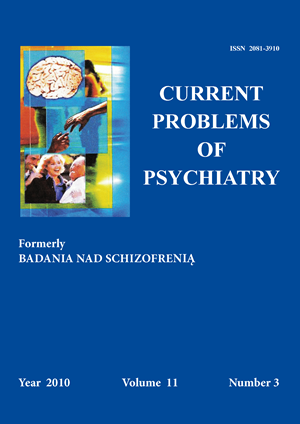Problemy kliniczne w terapii zaburzeń preferencji seksualnych – cześć druga
Słowa kluczowe:
parafilia, farmakoterapia, psychoterapiaAbstrakt
Dewiacja seksualna (parafilia) jest to stan erotoseksualnej, powtarzającej się reaktywności lub obsesyjnej zależności od niezwykłego, nieakceptowanego bodźca zmysłowego lub istniejącego w fantazji, niezbędnego do uzyskania lub podtrzymania podniecenia seksualnego i/lub orgazmu. Zgodnie z kryteriami zawartymi w ICD-10, aby postawić pewne rozpoznanie zaburzeń preferencji seksualnych muszą być spełnione następujące warunki: 1. Osoba doświadcza powtarzającego się, nasilonego popędu i wyobrażeń seksualnych dotyczących niezwykłych przedmiotów lub działań, 2. Osoba zarówno realizuje ten popęd, jak i odczuwa z tego powodu wyraźne cierpienie, 3. Opisana preferencja występuje od co najmniej 6 miesięcy.
Celem części pierwszej pracy jest charakterystyka wybranych parafilii (pedofilia, fetyszyzm, ekshibicjonizm, oglądactwo, tranzwestytyzm fetyszystyczny, sadyzm) oraz przybliżenie zagadnień związanych z obecnie dostępnym leczeniem biologicznym (farmakoterapią i leczeniem chirurgicznym). W części drugiej, autorzy przedstawili podstawowe zagadnienia związane z psychoterapią (indywidualną oraz grupową) zaburzeń preferencji seksualnych.
Bibliografia
1. Hill A., Briken P., Kraus C., Strohm K., Berner W. Differential pharmacological treatment of paraphilias and sex offenders. Int. J. Offender Ther. Comp. Criminol., 2003; 47: 407-421.
2. Lew-Starowicz Z. Seksuologia XXI wieku. Rocznik Lubuski, 2006; 32(2): 13-18.
3. Berner W., Briken P. Paraphilia, sexual preference disorders. Diagnosis, etiology, epidemiology, treatment and prevention. Bundesgesundheitsblatt Gesundheitsforschung Gesundheitsschutz, 2007; 50(1): 33-43.
4. Briken P., Welzel K., Habermann N., Hill A., Berner W. Antiandrogenic pharmacotherapy of sexual offenders and home leave steps in the Forensic Psychiatric Hospital Berlin. Psychiatr. Prax., 2009; 36 (5): 232-237.
5. Bradford J., Pawlak A. Double-blind placebo crossover study of cyproterone acetate. Arch. Sex. Behav., 1993; 22(5): 383-402.
6. Reilly D.R., Delva N.J., Hudson R.W. Protocols for the use of cyproterone, medroxyprogesterone and leuprolide in the treatment of paraphilia. Can. J. Psychiatry, 2000; 45 (6): 559-563.
7. Cooper A.J., Sandhu S., Losztyn S., Cernovsky Z. A double-blind placebo controlled trial of medroxy-progesterone acetate and cyproterone acetate with seven pedophiles. Can. J. Psychiatry, 1992; 37(10): 687-693.
8. Grossman L.S., Martis B., Fichtner C.G. Are sex offenders treatable? A research overview. Psychiatr. Serv., 1999; 50(3): 349-361.
9. Kratochvil S. Leczenie zaburzeń seksualnych. Warszawa; Iskry: 2002.
10. Abouesh A., Clayton A. Compulsive voyeurism and exhibitionism: A clinical response to paroxetine. Arch. Sex. Behav., 1999; 28(1): 23-30.
11. Coskun M., Motavall Mukaddes N. Mirtazapine treatment in a subject with autistic disorder and fetishism. J. Child Adolesc. Psychopharmacol., 2008; 18(2): 206–209.
12. Fedoroff J.P. Buspirone hydrochloride in the treatment of an atypical paraphillia. Arch. Sex. Behav., 1992; 21(4): 401-406.
13. Levenson J.S., Prescott D.S., D'Amora D.A. Sex offender treatment: consumer satisfaction and engagement in therapy. Int. J. Offender Ther. Comp. Criminol., 2010; 54(3): 307-326.
14. Stürup G.K. Treatment of the sex offender. Castration: the total treatment. Int. Psychiatry Clin., 1971; 8(4): 175-96.
15. Jasiński M. Psychoterapia osób z zaburzeniami seksualnymi. W: Grzesiuk L. red., Psychoterapia. Warszawa; Eneteia: 2006. s. 491-505.
16. Marcinek P., Peda A. Terapia sprawców przestępstw seksualnych w warunkach izolacji więziennej. Seksuol. Pol., 2009; 7(2): 59–64.
17. Salton W. Perseveration in the twenty-first century: from the holocaust to the karaoke bar. Psychoanal. Rev., 2004; 91(1): 99-111.
18. Gabbard G.O., Bennett T.J. Dilemmas in the psychotherapy of sexually impulsive patients. Am .J. Psychiatry., 2005; 162(5): 859-865.
19. Rutkowski R., Sroka W. Projekt systemu oddziaływań terapeutycznych wobec sprawców przestępstw na tle seksualnym w okresie odbywania kary pozbawienia wolności. Seksuol. Pol., 2007; 5(1): 1-8.
20. Langevin R., Langevin M., Curnoe S. Family size, birth order, and parental age among male paraphilics and sex offenders. Arch. Sex. Behav., 2007; 36: 599-609.
21. Blanchard R. Quantitative and theoretical analyses of the relation between older brothers and homosexuality in men. J. Theor. Biol., 2004; 230: 173-187.
22. Marshall B. Unconscious guilt as an explanation for male genital exhibitionism. Smith College School for Social Work; 2004.
23. Hall R., Richard C., Hall W. A profile of pedophilia: definition, characteristics of offenders, recidivism, treatment outcomes, and forensic issues. Mayo Clin. Proc., 2007(82): 457-471.
24. Salter D., McMillan D., Richards M., Talbot T., Hodges J., Bentovim A., Hastings R., Stevenson J., Skuse D. Development of sexually abusive behaviour in sexually victimized males: a longitudinal study. Lancet, 2003; 361: 471-476.
25. Repique R.J. Assessment & treatment of persons with pedophilia. J. Psychosoc. Nurs. Ment. Health Serv., 1999; 37(12):19-23.
26. Sokolik Z. Czynniki leczące w psychoanalizie. W: Grzesiuk L. red., Psychoterapia. Warszawa; Eneteia: 2005, s. 44-49.
27. Cannon D.S., Baker T.B., Gino A., Nathan P.E. Alcohol-aversion therapy: relation between strength of aversion and abstinence. J. Consult. Clin. Psychol., 1986; (54)6: 825-830.
28. Wilson J.E., Wilson K.M. Amelioration of sexual fantasies to sexual abuse cues in an adult survivor of childhood sexual abuse: a case study. J. Behav. Ther. Exp. Psychiatry, 2008; 39(4): 417-423.
29. Hodgins D.C., Peden N. Cognitive-behavioral treatment for impulse control disorders. Rev. Bras. Psiquiatr., 2008; 30: 31-40.
30. Edwards D. Mental Health's cold shoulder treatment of pedophilia. Behav. Healt. Management, 2004; 24(3): 32-35.
31. Tryjarska B. Psychoterapia grupowa. W: Grzesiuk L. red., Psychoterapia. Warszawa; Eneteia: 2006, s. 17-75.
32. Hill A., Habermann N., Berner W., Briken P. Psychiatric disorders in single and multiple sexual murderers. Psychopathology, 2007; 40: 22-28.
33. Långström N., Hanson R.K. High rates of sexual behavior in the general population: correlates and predictors. Arch. Sex. Behav., 2006; 35(1): 37-52.
34. Auburn T., Lea S. Doing cognitive distortions: A discursive psychology analysis of sex offender treatment talk. Br. J. Soc. Psychol., 2003; 42: 281-289.
35. Lothstein L.M. Treatment of non-incarcerated sexually compulsive/addictive offenders in an integrated multi-modal and psychodynamic group therapy model. Int. J. Group. Psychother., 2001; 51(4): 553-570.
36. Czabała J. Czynniki leczące w psychoterapii. Warszawa; PWN: 2009.


